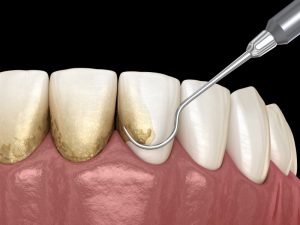 If you think bleeding gums aren’t that big of a deal, guess again. Not only is it abnormal for the soft tissue to bleed while brushing and/or flossing, but it can be a sign of gum disease. If left untreated, it can quickly advance to a damaging stage that may result in bone and tooth loss. Because there are different stages of gum disease, your dentist wants you to know what to look for and how to prevent it altogether.
If you think bleeding gums aren’t that big of a deal, guess again. Not only is it abnormal for the soft tissue to bleed while brushing and/or flossing, but it can be a sign of gum disease. If left untreated, it can quickly advance to a damaging stage that may result in bone and tooth loss. Because there are different stages of gum disease, your dentist wants you to know what to look for and how to prevent it altogether.
What is Gingivitis?
Do you notice that your gums look inflamed and bleed easily while brushing? This isn’t occurring for no reason. It’s because you have early stages of gum disease, also known as gingivitis. This develops when plaque forms around the gum line, causing them to become irritated. A good thing to note is that even if you develop gingivitis, your teeth are still held firmly within their sockets, so the infection hasn’t progressed at this point. You also don’t need to worry about irreversible bone or tissue damage. If you’re still unsure if you might have gingivitis, you can look for:
- Red, puffy gums
- Bleeding while brushing and/or flossing
- Bad breath
- Tender gums
You and your dentist can work together to reverse gingivitis before it progresses. With a thorough cleaning and good oral habits practiced at home, you can quickly get your oral health back on track.
What is Periodontitis?
If gingivitis is left untreated, it can advance into the next stage, which is known as periodontitis. When this happens, your gums will begin to pull away from your teeth creating pockets that can trap food and bacteria. Infection will set in, and your body will attempt to fight it off while the bacteria and plaque spread below the gum line.
Once it reaches this point, you may experience bone deterioration because of the bacteria, and your pockets will deepen. The result is bone and tooth loss, which leads to extensive dental work and more money out of your pocket.
Before it progresses to a point where you are losing teeth, your dentist can perform a scaling and root planing procedure to scrape away the plaque and bacteria and smooth out the tooth root. If your teeth become loose, your dentist may need to extract them if they are damaged too greatly.
Symptoms of periodontitis include:
- Bleeding gums
- Receding gums (those that pull away from your teeth and make them look longer)
- Spaces that develop between your teeth
- Bright red or purplish gums
How Can I Prevent Gum Disease?
Gum disease can not only be harmful to your oral cavity, but it can lead to other detrimental diseases such as diabetes, stroke, heart disease, respiratory conditions, Alzheimer’s or loss of cognitive brain function, and more.
To prevent gum disease from developing, here are a few quick tips:
- Brush and floss regularly
- Rinse with an antiseptic mouthwash
- Visit your dentist for regularly scheduled appointments (every six months)
- Clean your tongue
- Maintain a well-balanced, nutrient-rich diet
If you notice any of the signs associated with gingivitis or periodontitis, make an appointment with your dentist immediately.
About the Practice
When it comes to taking proper care of your teeth and gums, Darby Creek Dental is here to help. Our team of experienced doctors and expert team members offer a wide range of dentistry services to meet your dental needs. From preventative checkups to advanced restorative care, we’ll take care of your entire family in one location! We use state-of-the-art technology to create accurate and comfortable results, and we are here to serve you with early morning office hours for those with hectic schedules. To learn more about our dental office and services, contact us at (937) 644-8822.

